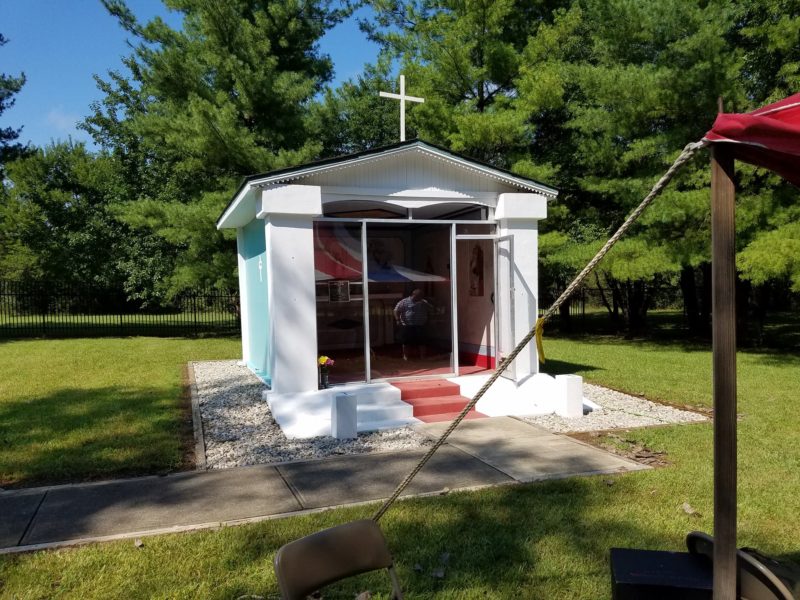Camp Atterbury
 On 11 December 1941, four days after the Japanese attack on the American navy base at Pearl Harbor, Mussolini’s Italy declared war on the United States to fulfill a treaty commitment to its allies, Japan and Germany. Italian prisoners of war (POWs) captured on the battlefields of North Africa were transported across the Atlantic Ocean to the Camp Atterbury internment facility, 30 miles south of Indianapolis. On 30 April 1943, 767 POWs opened the camp and by late summer 3,000 Italian servicemen resided there.
On 11 December 1941, four days after the Japanese attack on the American navy base at Pearl Harbor, Mussolini’s Italy declared war on the United States to fulfill a treaty commitment to its allies, Japan and Germany. Italian prisoners of war (POWs) captured on the battlefields of North Africa were transported across the Atlantic Ocean to the Camp Atterbury internment facility, 30 miles south of Indianapolis. On 30 April 1943, 767 POWs opened the camp and by late summer 3,000 Italian servicemen resided there.
Some POWs volunteered to work on farms in Johnson and adjoining counties to escape the boredom of camp and alleviate the severe shortage of local farm labor. Other POWs were skilled artisans, trained in the use of wood, stone, masonry, and painting. They disliked the camp’s wooden chapel and wanted a place to worship which reflected their own heritage and felt like home. During their off-duty hours as a sign of faith, with the encouragement of their chaplain, Franciscan Father Maurice F. Imhoff, and the support of camp authorities, the prisoners began construction of “The Chapel in the Meadow,” a small white brick and stucco building just large enough for the priest and servers (11 by 16 feet). Three sides were walled in, but the fourth or southern side was open to the weather. The POWs used surplus material from other projects and mixed dyes from berries, other plants, and their own blood to obtain the proper hue. They painted the eye of God on the ceiling, a cross flanked by cherubs over the altar, the Dove of Peace, and images of the Madonna, Anthony of Padua, and Francis of Assisi on the two side walls. The altar was painted to look like marble, and the floor was painted red to simulate a carpet. A second altar was constructed so that Mass could be celebrated outside in good weather.
The project finished, Chaplain Imhoff dedicated the chapel to the Blessed Virgrn Mary. On the weekend of 16-17 October 1943, Most Reverend Amleto Cicognani, Apostolic Delegate to the United States, celebrated Mass there and preached to the POWs in Italian. In their turn, the POWs held a special parade to salute the Delegate and entertained him with their own 45-piece orchestra playing selections from Mascagni’s Cavalleria Rusticana.
After Mussolini was forced from power, Italy joined the Allied side in September 1943. Soon the POWs were transferred to other camps and then sent home. By 4 May 1944 all Italians had departed Atterbury to make way for German POWs who remained there until 1946.
The Chapel in the Meadow fell into disrepair and became a major camp eyesore. Fishermen and campers at nearby Stone Arch Lake used it as a rain shelter, built fires in it, littered it with beer cans, and defaced it with graffiti. Local sharpshooters used it for target practice.
In 1983 students in the social studies and science class at Custer Baker Middle School, Franklin, Indiana, published their research on the Atterbury POW camp and the Chapel in the Meadow. Several local people, as well as Post Commander Jorg Stachel, became interested in the restoration of the chapel, and in 1988 the State Adjutant General announced that non-appropriated funds would be used for the project. A glass window and door were installed on the south side to protect the interior from the weather and intruders. Norma King, artist-wife of a former post commander, began to renovate the murals. H. E. Henderson, Inc. of Fairland, Indiana, repaired the building and post staff members improved the grounds. On 16 September 1989 Father Patrick A.Doyle, administrator of Holy Rosary parish, rededicated the refurbished chapel in the presence of former Italian POWs, the Italian military attache in Washington, the Italian consular agent for Indiana, local devotees of the chapel, and members of the Italian community.
In subsequent years Colonel Stachel and his successor, Colonel Garry L. Willis, approved the use of the chapel grounds for a pitch-in picnic co-sponsored by the Indiana National Guard and the Columbus ’92 Commission (now Italian Heritage Society). On a Sunday in early August, Father John N. Sciarra, retired pastor of St. Barnabas parish, lndianapolis, celebrated Mass for the hundreds of picnickers including some former Italian POWs. Rosary, Mass, picnic, music, bocce, conversation, and camp tours have become part of the annual event. In 1991 a right-wing Protestant fundamentalist was charged with extensively vandalizing the chapel. Three years later, Sciarra, accompanied by former Italian POW Libero Puccini and a Fourth Degree honor guard, Knights of Columbus, consecrated the chapel and surrounding grounds to the Most Imaculate Heart of Mary as a haven of peace and prayer for all those in need.
– James J. Divita
